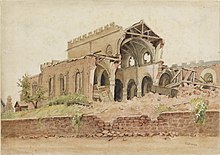
Devon is a ceremonial county in South West England. It is bordered by the Bristol Channel to the north, Somerset and Dorset to the east, the English Channel to the south, and Cornwall to the west. The city of Plymouth is the largest settlement, and the city of Exeter is the county town.

Ecgberht, also spelled Egbert, Ecgbert, Ecgbriht, Ecgbeorht, and Ecbert, was King of Wessex from 802 until his death in 839. His father was King Ealhmund of Kent. In the 780s, Ecgberht was forced into exile to Charlemagne's court in the Frankish Empire by the kings Offa of Mercia and Beorhtric of Wessex, but on Beorhtric's death in 802, Ecgberht returned and took the throne.
Leofric was a medieval Bishop of Exeter. Probably a native of Cornwall, he was educated on the continent. At the time Edward the Confessor was in exile before his succession to the English throne, Leofric joined his service and returned to England with him. After he became king, Edward rewarded Leofric with lands. Although a 12th-century source claims Leofric held the office of chancellor, modern historians agree he never did so.
Dumnonia is the Latinised name for a Brythonic kingdom that existed in Sub-Roman Britain between the late 4th and late 8th centuries CE in the more westerly parts of present-day South West England. It was centred in the area of modern Devon, but also included modern Cornwall and part of Somerset, with its eastern boundary changing over time as the gradual westward expansion of the neighbouring Anglo-Saxon kingdom of Wessex encroached on its territory. The spelling Damnonia is sometimes encountered, but that spelling is also used for the land of the Damnonii, later part of the Kingdom of Strathclyde, in present-day southern Scotland. The form Domnonia also occurs and shares a linguistic relationship with the Breton region of Domnonée.
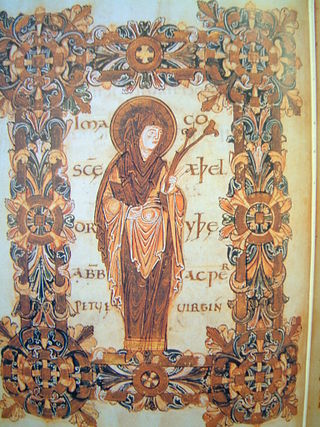
Æthelthryth was an East Anglian princess, a Fenland and Northumbrian queen and Abbess of Ely. She is an Anglo-Saxon saint, and is also known as Etheldreda or Audrey, especially in religious contexts. She was a daughter of Anna, King of East Anglia, and her siblings were Wendreda and Seaxburh of Ely, both of whom eventually retired from secular life and founded abbeys.

Botolph of Thorney was an English abbot and saint. He is regarded as the patron saint of boundaries, and by extension, of trade and travel, as well as various aspects of farming. His feast day is celebrated either on 17 June (England) or 25 June (Scotland).

The Flag of Devon, properly St Petroc's Cross, is the flag of the English county of Devon. It is dedicated to Saint Petroc, a local saint with numerous dedications throughout Devon. It is notable for its creation through two web-based polls.

The history of Cornwall goes back to the Paleolithic, but in this period Cornwall only had sporadic visits by groups of humans. Continuous occupation started around 10,000 years ago after the end of the last ice age. When recorded history started in the first century BCE, the spoken language was Common Brittonic, and that would develop into Southwestern Brittonic and then the Cornish language. Cornwall was part of the territory of the tribe of the Dumnonii that included modern-day Devon and parts of Somerset. After a period of Roman rule, Cornwall reverted to rule by independent Romano-British leaders and continued to have a close relationship with Brittany and Wales as well as southern Ireland, which neighboured across the Celtic Sea. After the collapse of Dumnonia, the remaining territory of Cornwall came into conflict with neighbouring Wessex.

Walstan was an Anglo-Saxon prince, known for the miracles which occurred during and after his life after he became a farm worker. He is a patron saint of farm animals and agricultural workers, who once visited his shrine at the church at Bawburgh, in the English county of Norfolk. Two sources for his life exist: the De Sancto Walstano Confessore in the Nova Legenda Angliæ, printed by Wynkyn de Worde in 1516, and known as the English Life; and a later Latin manuscript copied in 1658 from a now lost medieval triptych, now in the Lambeth Palace library in London.
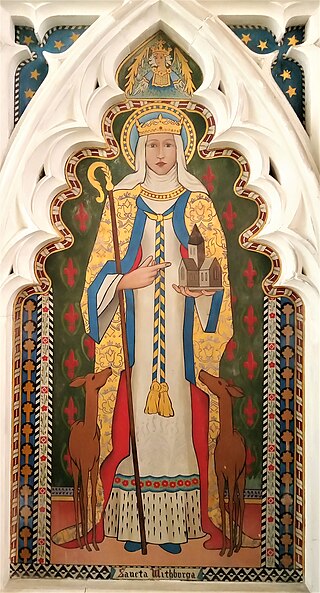
Wihtburh was an East Anglian saint, princess and abbess. According to tradition, she was the youngest daughter of Anna, king of the East Angles, but Virginia Blanton has suggested that the royal connection was probably a fabrication. One story says that the Virgin Mary sent a pair of female deer to provide milk for Wihtburh's workers during the construction of her convent at Dereham, in Norfolk. When a local official attempted to hunt down the does, he was thrown from his horse and killed.
Kea was a late 5th-century British saint from the Hen Ogledd —the Brythonic-speaking parts of what is now southern Scotland and northern England. According to tradition he was chiefly active in Cornwall, Devon and Brittany, and his cult was popular in those regions as well as throughout Wales and the West Country. Fili or Filius, to whom the parish church of Philleigh is dedicated, probably came from Wales and is said to have been a companion of Kea.
Juthwara or Jutwara was a virgin and martyr from Dorset. According to her legend, she was an eighth-century Saxon, and sister to Sidwell, though some historians have theorised she was a Briton living in the sixth century. Her relics were translated to Sherborne during the reign of Ethelred the Unready. Nothing further is known with certainty about her life.

Urith was a Christian woman from the Westcountry of Great Britain who was alleged to have been martyred in the 8th century, and subsequently revered as a saint. The name is still common in the English county of Devon. Her feast day is 8 July and her shrine is located in the North Devon village of Chittlehampton. Her name is also known in Latin as Hieritha and occasionally corrupted to Erth.

Saint Budoc of Dol was a Bishop of Dol, venerated after his death as a saint in both Brittany and Devon. Saint Budoc is the patron of Plourin Ploudalmezeau in Finistère where his relics are preserved. His feast day was celebrated on 8 December, the date still used in Devon, but in Brittany this was moved to 9 December.
Events from the 10th century in the Kingdom of England.

Various monasteries and other religious houses have existed at various times during the Middle Ages in the city of Exeter, Devon, England.

Michael James Swanton is a British historian, linguist, archaeologist and literary critic, specialising in the Anglo-Saxon period and its Old English literature.

Exeter is a cathedral city and the county town of Devon, South West England. It is situated on the River Exe, approximately 36 mi (58 km) northeast of Plymouth and 65 mi (105 km) southwest of Bristol.
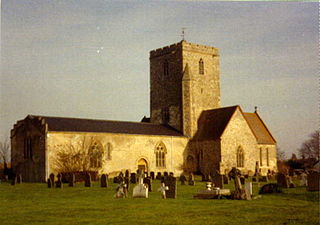
Wilgyth of Cholsey was a 6th-century Catholic female saint from Anglo-Saxon England who was venerated locally in Berkshire.
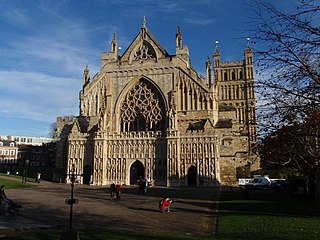
Nicholas Marston was a 16th century English priest. It is uncertain whether his appointment as Archdeacon of Cornwall in 1574 took effect. He was one of three brothers, who had ecclesiastical careers in the Cathedral church of Exeter, and in that diocese within Cornwall and Devon. Their father was a wealthy citizen Haberdasher in the city of London who gave financial support to the early career of his wife's brother William Bradbridge, later bishop of Exeter. Thomas's daughters made advantageous City marriages, and the network of their mercantile patronage and relations with the bishops, deans and chapters of Exeter and of Bath and Wells, and with the University of Oxford, spanned several decades of the Tudor and early Stuart period.

